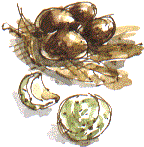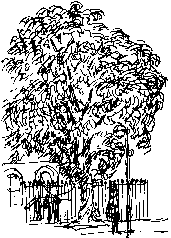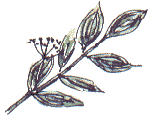 |
Bizarre FruitsSaturday 30th September 2000, 2/2, West Yorkshire |
![]()
![]()
![]()
![]()
![]() Nature
Diary Rocks
History
Workshop
Links
Home Page
Nature
Diary Rocks
History
Workshop
Links
Home Page
![]()
 THE FOLIAGE of Horse Chestnuts is starting to change colour in Thornhill Park. Each tree has at least one boy standing beneath it, gathering the conkers that have fallen, or, more often, throwing a stick up to try and dislodge the ones that aren't ripe yet.
THE FOLIAGE of Horse Chestnuts is starting to change colour in Thornhill Park. Each tree has at least one boy standing beneath it, gathering the conkers that have fallen, or, more often, throwing a stick up to try and dislodge the ones that aren't ripe yet.Walnut
A few fruits, which look a bit like conker shells without the prickles, lie on the grass beneath the Walnut behind the Old Rectory. I collect a few to draw. Opening one, I get the inner pith over my hands and under my finger nails. This pith soon turns reddish brown and it seems to stain anything it touches. As I type this a day later, I've still got a conspicuous brown mark under my thumb nail - and we're supposed to be going out to dinner. I'll have to have another go with the scrubbing brush.
As I type this a day later, I've still got a conspicuous brown mark under my thumb nail - and we're supposed to be going out to dinner. I'll have to have another go with the scrubbing brush.The book The Fruits of the Earth, beautifully illustrated by Marilena Pistoia, points out that this so-called nut is, botanically speaking, a globose drupe. I don't see globose drupes catching on in health food stores.
- Drupe - the seed, usually just the one, is enclosed in a pip or stone, surrounded by a fleshy covering. Examples; plum, blackberry.
- Berry - The seeds, usually many of them, are enclosed in a fleshy covering. Examples; Lemon, Gooseberry, Tomato, Grape.
- Nut - a single dry fruit with a woody shell which is often contained in a cuplike structure. Examples; Horse Chestnut, Acorn, Hazelnut.
I dig out the nutcrackers, which have been in the draw since Christmas, and crack open the inner shell to taste the nut. It's very watery, almost tasteless. Perhaps they aren't ripe. Apparently as the walnut dries out the proportion of nitrogen compounds and lipids - waxy, oily fats - increases.
The book quotes an English rhyme, which it describes as 'old, and certainly untrue';
'A woman, a dog and a walnut tree; the more you beat them, the better they be.'A walnut tree was often planted in a stableyard to keep flies away from the horses. The leaves have also been recommended for killing slugs (that's if they've escaped the fly agaric).
Cornelian Cherry?
 At the top of Millbank there's a tree that I've been puzzled about. I've always assumed it was either Spindle or Dogwood, but now it is in fruit I think that it is more likely Cornelian Cherry , an introduced species. The fruits, borne singly on the branches are like oval and very squishy cherries, each containing a large stone. I have to wipe the red pulp off my hands after squashing one.
At the top of Millbank there's a tree that I've been puzzled about. I've always assumed it was either Spindle or Dogwood, but now it is in fruit I think that it is more likely Cornelian Cherry , an introduced species. The fruits, borne singly on the branches are like oval and very squishy cherries, each containing a large stone. I have to wipe the red pulp off my hands after squashing one.A tree expert friend has offered to try and identify the species if I take him leaf at the next naturalists' meeting. I'll let you know if I find out.
![]()
Richard Bell,
wildlife illustrator
E-mail; 'richard@willowisland.co.uk'
![]() Next page
Previous page
Nature Diary
Wild
West Yorkshire home page
Next page
Previous page
Nature Diary
Wild
West Yorkshire home page
![]()